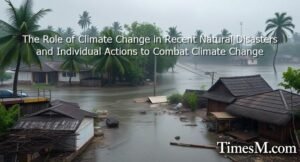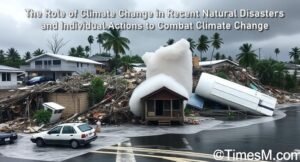
In the contemporary world, climate change is one such unique challenge that very practically poses all sorts of threats to environmental or socio-economic factors. More and more climatic disasters come to light as hurricanes, wildfires, droughts, and floods during the past few years, increasing both in number and intensity. Scientists have made the observation that the extreme climatic changes may have their root cause in an increase in temperatures worldwide due to human activity effects It is the acts of nature that tend to nurture global warming and raise contentious issues due to emissions of CO2, mainly due to human activities; it’s, therefore, confined to man’s moral responsibility to make it happen.
The Relationship Between Natural Disasters and Climate Change
Climate changes on oceanic and atmospheric conditions that in turn change weather parameters with an increase in frequency of natural disasters. Studies on climate reveal that higher temperatures and increased moisture in the atmosphere would at times result in torrential rains and floods. Conversely, higher temperatures mean wind movement, implying wildfires with long occurrences of drought. To add, melting glaciers and increased temperature would mean increased sea levels, thus with coastal flooding.
Hurricanes and Typhoons
Sea temperature changes will be a muse for hurricanes and typhoons as powerful storms. With existing climate science, storm intensification occurs very fast. Indeed, rapid intensification will have serious and disastrous consequences as would be shown in events like the hurricane Harvey in 2017 and typhoon Haiyan in 2013, being all countries of the world. These storm surges coupled with rising sea levels will ravage inland along the coasts.
Wildfires
Climate change is now a settled connection with fires; increase in temperatures and dry seasons longer than normal have definitely helped fires to spread. Recent incidents in California, Australia and the Mediterranean have destroyed ecosystems and displaced thousands of people. The scientists are in agreement in saying that climate change has heightened the frequency and intensity of these fires, rendering them more difficult to contain and thereby more devastating on biodiversity.
Floods and Heavy Rainfall
Thus, today-the very real cloud of climate change is looming over rainfall events in real time. All predictions are quite clear-it has been recorded that as temperatures increase, the moisture in the air increases, and then comes the booming sound of more torrential rains. Floods have taken victims first in Africa, the next in Germany, then in China, and finally in India-all of them-to some measure, to a large-scale loss of life and property. Urbanization accentuates the effect of poorly designed drainage systems upon the flood effects of climate change problems.
Droughts and Desertification
With extreme climate variability, areas of great concern witness occurring long dry spells and changing farming systems, water supply, and food security. According to climate data from around the world, typified regions include sub-Saharan Africa, western United States, and patches of particular Southwest areas in South America where unprecedented drought incidence has been recorded. This dry occasion has proved to be desertification depriving arable land and threatening livelihoods looked upon as a function of agriculture.
The Economic and Social Impacts of Climate-Driven Disasters
Economic and social repercussions of climate-related disasters are of a wide-ranging nature. Directorate costs incurred from climate impacts like damages to infrastructure, dislocation of persons, or health and healthcare burdens put great strain within Governments and communities. Those countries that suffer frequent disaster impacts undergo challenges in returning to normalcy, which translates into economic instability. Further, reality is being turned to millions that will have to become climate migrants after being displaced from sustainable habitation because of conditions unfit for living.
Individual Actions to Combat Climate Change
Indeed, global challenge involves climate change which requires systematic effort and individualizing responsibility into reducing carbon footprints and better practices for living sustainably. Alone, conscious choices around energy, transport, and lifestyles accrue into really great effects.
Reducing Carbon Footprint
There are myriad people, each coming up with their own diverse approaches in the mitigation of climatic change and reduction of individual carbon footprints. Such apt leveraging of energy appliances, LED light ing, or other installations could actually reduce greenhouse gases on account of an end-user’s activity. It could even supplement an individual against fossil fuel dependency through solar or wind resources.Carbon footprint is among the most effective forms of combating climate change. Energy-efficient appliances, LED lighting, and insulation of house would all contribute to greenhouse-gas emission reductions. The other has been using wind or solar energy sources to completely cut ties with fossil fuels.
Sustainable Transportation Choices
Transportation is amongst the major causes of carbon emissions around the globe. Besides walking, biking, carpooling, and using public transports that help with pollution reduction, eco-friendly commuting options are in the form of public transit, driving an electric vehicle (EV), or a hybrid electric vehicle. Taking fewer flights and offsetting flight carbon emissions would further assist in lowering the carbon footprint of an individual.
Adopting a Sustainable Diet
Many people are ignorant of the fact that one’s dietary choice and consumption can modify the entire course of climate change. Quite a number of livestock studies reveal that a lot of methane emissions have been generated through livestock farming, giving rise to the increase in global warming. Reducing meat consumption, particularly beef and lamb, becomes one significant aspect of a mostly plant-based or omnivorous diet. With regards to environmental impact, it recommends eating locally and organically grown food sources to reduce the carbon footprint that comes from food transport and production. Costumes, indeed, have their part to play in climate change. All other chief causes of contributing factors someone does not see. For example, extensive research in the area of climate change has shown how livestock farming contributes a considerable amount to the global warming involving methane emissions. Reducing beef and lamb consumption and adopting the vegetarian or flexitarian diet has the potential to offset carbon footprints from one’s activities. Promoting local and organic food sources also reduces the carbon footprint of food delivery and production for the country. It is something about which many individual people do not realize how much dietary choice and consumption has altered the path of climate change. For example, climate research has made it clear that a significant amount of methane emissions generated from livestock farming contributes immensely to increasing global warming. One countermeasure against a person’s environmental impact would be to reduce meat consumption, especially beef and lamb, and put these persons on a plant-based or flexitarian diet. Also, encourage local and organic food sources as that also reduces the carbon footprint associated with food transport and production. Most people do not realize how lifestyle-related food choices and consumption choices affect global warming. For instance, some climate studies indicate that livestock generates a huge amount of methane gas contributing to global warming. So, by shaving beef or lamb meat off the plate and transitioning to a more plant-based or flexitarian diet, a particular person can uncreate his or her carbon-time on the environment. Supporting regional and organic farmers further lowers the carbon footprint associated with food production and transportation.
Waste Reduction and Recycling
Another really important thing regarding climate change is waste reduction. Composting, reusing, or using less plastic minimises landfill garbage and methane emissions. Simple but effective are the buy reusable products and avoid single use plastics, support with sustainable packing.
Supporting Renewable Energy
Individual efforts toward sustainable energy contribute to detaching the world from dependence on fossil fuels. Eco-friendly homeowners can install solar panels, enroll in green energy programs, and advocate for clean energy policy initiatives. Sustainable enterprises are tickling the war against greenhouse gases.
Water Conservation
In almost every region, water scarcity is being exacerbated by global climate change. Use water wisely in climate-sensitive trends: repair leaking taps, use water-efficient appliances, reduce unnecessary irrigation. The little things add up so that turning off water taps when not in use and collecting rainwater can take one a long way toward sustainable water usage.
Advocacy and Community Engagement
Individual choices for climate action are only the beginning; they reach outwards to encompass a much larger scope of action. While supporting climate legislation, working for an environmental organisation, or raising awareness are all forms of climate advocacy that bolster the import of any individual initiative, collective actions for change can include talking about sustainability, attending climate demonstrations, and voting for leaders who will deliver on their promises very seriously in terms of climate action.
The Role of Technology in Combating Climate Change
The innovations of climate are thus engaged in the fight against global warming. Climate tech solutions such as carbon capture and storage (CCS), energy-efficient smart grids, and sustainable agriculture techniques are bringing relief from the debilitating effects of climate. Artificial intelligence (AI) as well as data analytics are being used for predicting climate patterns, optimizing the use of resources, and minimizing emissions.
Global Collaboration in Addressing Climate Change
It’s a global understanding that climate change demands an action. International cooperations actually work as climate treaties, such as the Paris Agreement, in the quest to end the reliance on emissions and promote a sustainable society. Countries, corporations, and individuals have to work together to achieve climate goals and promote a greener future.

Conclusion
In the fight against climate change, policies and technologies alone will not prevail. Therefore, since climate change is anthropocentric, there is quite a sustainable disaster response and restoration depending on individual decisions: energy consumption, transportation, diet, waste. In order to prevent climate action from falling further down the global agenda, this is enhanced through climate activism and community intervention. The current moment is crucial; working in concert, we can make our impact shine on humanity’s path with a brighter and robust planet for the future.
